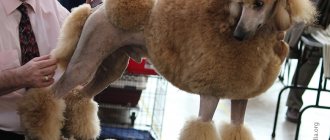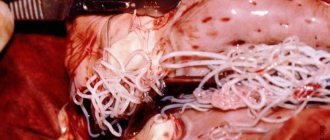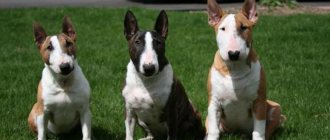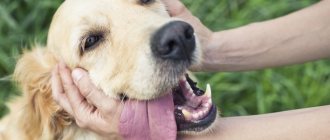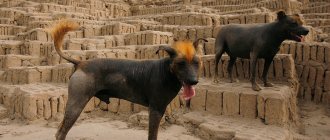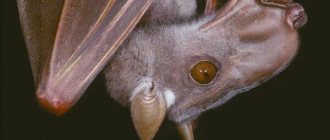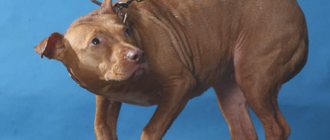Animal rights activists actively condemn this operation, citing its harshness and unreasonableness. Due to numerous disputes, it is not entirely clear whether it is possible to dock a dog’s tail or whether it is still worth preserving the natural appearance of the animal.
The official ban on amputation of the tail vertebrae in Russia has not yet been adopted, so the final decision remains with the owner. To avoid remorse, be sure to familiarize yourself with possible complications before signing up for the procedure.
Photo gallery
Photo 1. Regular Rottweiler
Photo 2. Rottweiler with amputated tail
Photo 3. Spaniels with a regular tail
Photo 4. Spaniel after docking
Photo 5. Doberman with a tail
Photo 6. Doberman after docking
Functional load
But here's what zoologists pay attention to:
- First of all, the tail has a communicative function. This is a means of communication with other animals, and since the dog lives with a person, it also lives with him.
- The second point is that the tail can serve as an assistant when moving.
- Beauty. Yes, in the animal world this fact is also of significant importance. During the mating season, males use it to attract the attention of females.
- Finally, it is simply an extension of the spine. Would you like to have several vertebrae removed?
It is already becoming clear why a dog needs a tail. Now let's look at why a person decided to deprive a pet of a legal organ.
A little history
In the 18th century, residents of England had to pay a dog tax on every four-legged representative, unless he was a service dog, for which tail docking was a mandatory procedure.
The reason for removing the tail of many dogs in those days was to allow hunting dog owners to evade responsibility for poaching. Hunting dogs did not have their tails docked. Shepherds of sheep flocks were exempt from paying the tax. They docked the tails of their assistance dogs to reduce their injury in fights with predatory animals. Therefore, many residents of Foggy Albion, in order to avoid taxes, cut off the tails of their pets, showing that the dog was a representative of the service. Over time, laws changed, the tax was abolished, but bobtail remained a necessary attribute of some breeds.
Cupping provided by the standard
Life is tailless
Why does a dog need a tail? This organ in such animals serves as a kind of steering wheel, a control lever. He is an active assistant when the pet is in fast motion, he suddenly needs to turn or run along a log or any uneven surface. It is also a way of communication that can tell a lot about the animal’s mood and intentions. Everyone knows about the positive wagging of the tail, which shows friendliness, or the tucking of the tail when fear is manifested. The animal makes sends with its tail, moving it to the left or to the right. Tailless dogs are deprived of this opportunity. So what good is cupping?
It turns out that the procedure comes from ancient times. In the old days they believed that docking saved dogs from such a serious disease as rabies. After some time, the tails began to be cut off for representatives of service or fighting breeds, as the most painful places. Animals intended for hunting were shortened so that they would not injure themselves by clinging to bushes.
Let's go. This has survived to this day, so it is difficult to imagine some breeds of these animals without docking.
But now there are new standards. In some European countries, docking of dogs is prohibited. Everything would be fine. For people who are, the length of the tail is not so important. The main thing is that he should be distinguished by loyalty, devotion, complaisance, and also be cheerful and cheerful. Difficulties arise when dog owners plan to take them to all kinds of exhibitions.
If specific evaluative standards are defined for tailed representatives, then what awaits those who are usually seen as tailless? True, docked animals are not yet deprived of attention in our country. They are usually given preference.
But over time, probably, such an inhumane operation will generally sink into oblivion. A clear indication that many European dog shows no longer consider docked representatives. And considering that there will be more and more such exhibitions, soon tailless dogs will completely step aside.
The conclusion here is quite clear. If you are counting on “career growth” for your pet at the European and world levels, then when choosing a breed, think about tailedness.
Of course, a lot can be said about whether a dog’s tail should be trimmed. There are many supporters of this procedure, as well as opponents. Only one thing is clear: tailless life does not bring much joy to the dogs themselves. So is it worth injuring a pet with this, albeit not so complex, surgical intervention just so that it matches the accepted appearance? Only its owner should decide this. As a result, a tailless dog lives and runs as usual, but it does not have full maneuverability, stability, or sociability. Therefore, you should not cut off this important part of her body unless absolutely necessary.
Puppy age suitable for surgery
We figured out why dogs are docked. Now, let's look at the average age of a pet at which surgery can be performed. Let's start with the fact that almost a third of all known breeds undergo surgery:
- Dobermans, Rottweilers;
- Great Danes;
- Setters, terriers;
- Boxers, poodles.
The list could go on for a long time, but the essence will not change. Cupping is a tradition that has survived to this day from ancient times. During the times of the Roman Empire, this operation was carried out on dogs for their activity - hunters, watchmen, rescuers, shepherds had no need for long dangling tails, which were considered an “extra attribute”.
Today, many consider the operation pointless - dogs living in the city are not involved in work (with the exception of the watchman), it turns out that there is simply no point in getting rid of ears and tails.
How the process works
Tail docking for puppies is carried out in 2 ways: using a tight rubber band or cutting with scissors. The first option is less traumatic and is performed without anesthesia.
Drag method
The veterinarian pulls the baby's skin to the base of the tail, finds the desired vertebra and secures it tightly with an elastic band. This tourniquet stops the blood flow, so within 5-7 days the tip dries out and falls off. The risk of bleeding is minimal, so sepsis is practically excluded.
Circumcision method
After anesthesia is administered, the desired area is fixed with fingers and trimmed. To stop bleeding, the cut site is clamped for 2 minutes, and to prevent infection, it is treated with an antiseptic.
The skin stretched to the base is returned and sutured, applying a sterile bandage. A crust forms at the amputation site, which disappears after 20-30 days.
At what age do dogs have their tail docked?
The owner decides when to dock a puppy’s tail, but veterinarians recommend not delaying it. After 1 month, pain sensitivity increases greatly, so it is best to circumcise before this point.
Surgery is easiest to tolerate in the first 3-10 days after birth. During this period, the tail vertebrae are very soft, and babies lack pain memory and increased sensitivity. For this reason, they do not require anesthesia or suturing, but animals older than 10 days are operated strictly under anesthesia.
Contraindications and prohibition for surgery
Contraindications include any health problems: weakness, loss of appetite, inflammatory reactions, infections. There is also an age limit. After 1 month, animals are not operated on. An official ban on surgical intervention has been adopted in all countries that have signed the European Convention.
Is it possible to do this yourself
Highly undesirable unless you are a long-time breeder. The procedure is carried out without anesthesia; at this age it is contraindicated. Moreover, no special equipment is required for this. But you shouldn’t do the operation yourself, unless you are an experienced breeder. But the ears are cropped at the age of two to three months under general anesthesia.
Possible complications
Knowing why dogs' tails are docked, owners should also be aware of the possible consequences of the operation. A cut off dog tail can affect:
- communication of the dog with other animals. The tail refers to the organs that are the means of communication. The dog may no longer be accepted by other animals. They often treat bobtails aggressively because they cannot determine their behavior;
- development of diseases associated with joints. Due to the removal of part of the vertebrae, the load will be distributed unevenly. This can lead to the development of a hernia. In addition, due to the removal of part of the tail, deformation of the toes of the hind limbs may occur;
- manifestation of increased aggression. Experts have proven that dogs that have undergone docking are much more aggressive than other dogs;
- psyche - veterinarians say that removal of the tail, even at an early age, causes severe pain to the animal. The stress experienced subsequently affects the pet’s psyche;
- coordination of movements, development of motor skills. A dog's tail is not just a means of communication, but also a movement regulator. Cropped pets often skid when turning and are unable to maintain balance.
Ear trimming also does not leave a permanent mark on dogs. The procedure can lead to the development of infectious diseases. The ears become completely unprotected from dirt, water and dust, which can cause the development of serious diseases.
Tail cutting is a difficult procedure that can lead to a number of complications.
Is it possible to leave it undocked?
It is not uncommon now to find undocked breeds whose ears and tails were previously trimmed. For example, a Doberman will not look too angry and dangerous. If the dog does not have medical indications for docking, then surgery may not be performed. The exception is service dogs, for whom the procedure is indicated for safety reasons.
The price of the procedure at the vet. clinics
The price of the procedure will depend on the method of docking, the age of the animal, and the location of the operation. Calling a veterinarian to your home is always more expensive than visiting a clinic.
On average, docking costs owners 700-1200 rubles, but depending on the prestige and location of the veterinary hospital, the price may increase or decrease.
To carry out the operation, it is better to choose a veterinarian with experience and good reviews. Cheap is not always high quality.
What dog breeds have their tails docked?
The mandatory presence of a docked tail is enshrined in the breed standard. The dog must conform to the exterior to participate in exhibitions and matings, but at this particular moment they increasingly turn a blind eye.
It is worth noting that many CIS countries and Russia still adhere to established traditions. Owners living there may find it difficult or even impossible to assign breeding or show class status to their pets if they refuse the operation.
List
The most famous representatives include
:
- poodles;
- kurtshaars;
- drathaars;
- Hungarian cops;
- Airedale Terriers;
- English and American cocker spaniels;
- boxers;
- Dobermans;
- toy terriers;
- Rottweilers.
The recommended tail length for these breeds is different. For this reason, it is very important to find an experienced veterinarian who is aware of all the nuances.
Determining the length of the ponytail
Most often, animals are left with 1/2-1/3 of their natural length or even 1-3 tail vertebrae. It all depends on the specific breed:
- poodles – 1/2-2/3;
- kurtshaars – 1/2-3/5;
- drathaars – 1/3-3/5;
- Hungarian cops – 1/2;
- Airedale Terriers – 1/3;
- English and American Cocker Spaniels – 2/5-1/2;
- boxers – 2-3 vertebrae;
- Dobermans – 2-3 vertebrae;
- toy terriers – 2-3 vertebrae;
- Rottweilers – 1-2 vertebrae.
Exceptions include wolfhounds. Their final length is determined solely by the owner.
Postoperative care
The owner must carefully monitor the dryness and cleanliness of the postoperative wound until it heals. Additional treatment is discussed with your veterinarian. Moisturizing ointments inhibit the regeneration process, so they are used only for their intended purpose.
If there are any signs of suppuration, contact your veterinarian immediately. Temporary separation from the mother will also be required. If she persistently licks the puppies' wounds, isolate her in a separate room and bring her to the pups only for feeding.
Animal after surgery
The main arguments against the procedure are postoperative pain and the loss of the main communication tool. There is also a possibility of complications, so monitor the condition of your four-legged pet very carefully during the postoperative period.
Is it painful for the puppy?
Surgery involves bones, cartilage and muscles, so the answer to this question is obvious. The pain continues in the postoperative period, when the anesthesia wears off. Not all pets have a high pain threshold. Particularly sensitive babies will cry for a long time and can even damage their vocal cords from too high-pitched whining.
Psychological factor
A dog's docked tail often provokes behavioral disorders. Due to impaired communication function, animals after surgery can withdraw into themselves and even show aggression towards their owners.
Communication methods
With a small appendage, it is very difficult to convey emotions and communicate with other four-legged animals. Most dogs avoid dogs with docked tails. They are less likely to approach them to get to know each other and very often show unreasonable aggression.
Are there any complications?
Most often, complications arise during tail docking in adult dogs. But here the blame falls entirely on the owner, who neglects contraindications.
Problems in children usually arise due to non-compliance with sterility or insufficient wound treatment in the postoperative period. In addition to bleeding and suppuration, it is worth noting the increased likelihood of scarring with prolonged healing. Such scars greatly spoil the appearance of the ponytail.
We should not forget about the deterioration of motor skills due to the loss of the “steering wheel”. This affects maneuverability and provokes improper distribution of the load on the hind legs and pelvic region. In some pets, this leads to muscle atrophy, limb deformities, intervertebral hernias and chronic pathologies of the genitourinary system.
